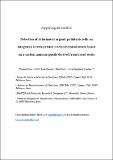Por favor, use este identificador para citar o enlazar a este item:
http://hdl.handle.net/10261/296347COMPARTIR / EXPORTAR:
 SHARE SHARE
 CORE
BASE CORE
BASE
|
|
| Visualizar otros formatos: MARC | Dublin Core | RDF | ORE | MODS | METS | DIDL | DATACITE | |

| Título: | Detection of chlorinated organic pollutants with an integrated screen-printed electrochemical sensor based on a carbon nanocomposite derived from bread waste |
Autor: | Duan, Wenchao; Baez Gaxiola, Martha Raquel; Gich, Martí CSIC ORCID; Fernández Sánchez, César CSIC ORCID | Palabras clave: | Ag-doped carbon nanocomposite Bread waste Sample-to-result electrochemical sensor Sucralose Trichloroacetic acid |
Fecha de publicación: | 20-dic-2022 | Editor: | Elsevier | Citación: | Electrochimica Acta 436: 141459 (2022) | Resumen: | Halogenated organic compounds are ubiquitous in water bodies due to anthropogenic activities and some of them pose a real threat to the aquatic environment and human health. That is the case of artificial sweeteners such as sucralose and haloacetic acid disinfection byproducts such as trichloroacetic acid (TCA), classified as contaminants of emerging concern. This motivates the search for rapid, cost-effective and easy-to-use analytical tools that could be deployed to facilitate the analysis of organohalide pollutants and aid in accurately monitoring water quality. This work explores the rapid detection of sucralose and TCA using a very simple miniaturized sample-to-result integrated electrochemical sensor. The device incorporates a screen-printed three-electrode electrochemical cell (SPE) where the working electrode is made of a nanocomposite of Ag nanoparticles and porous C (Ag/C). The material is prepared from bread waste, in an attempt to add value to one of the largest fractions of food leftovers and thus contribute to the sustainable circular economy. The electrochemical process behind the sensor analytical performance is initially evaluated using free Cl− ions in solution and then, the sensor is used to analyze the mentioned target analytes. A paper disk integrated over the electrode area and loaded with the reagents required for the sample conditioning makes the analysis straightforward. The sensor thus produced can be inserted in a highly compact low-power instrument connected to a mobile phone, making an easy-to-use device suitable for on-site analytical studies. | Versión del editor: | http://dx.doi.org/10.1016/j.electacta.2022.141459 | URI: | http://hdl.handle.net/10261/296347 | DOI: | 10.1016/j.electacta.2022.141459 | ISSN: | 0013-4686 |
| Aparece en las colecciones: | (ICMAB) Artículos |
Ficheros en este ítem:
| Fichero | Descripción | Tamaño | Formato | |
|---|---|---|---|---|
| Duan_ElectrActa_2022_editorial.pdf | Artículo principal | 4,76 MB | Adobe PDF |  Visualizar/Abrir |
| Duan_ElectrActa_2022_suppl_editorial.pdf | Información complementaria | 1,23 MB | Adobe PDF |  Visualizar/Abrir |
CORE Recommender
SCOPUSTM
Citations
2
checked on 03-may-2024
WEB OF SCIENCETM
Citations
1
checked on 22-feb-2024
Page view(s)
21
checked on 05-may-2024
Download(s)
30
checked on 05-may-2024
Google ScholarTM
Check
Altmetric
Altmetric
Este item está licenciado bajo una Licencia Creative Commons

